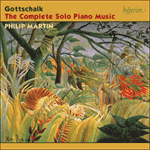
Welcome to Hyperion Records, a British classical label devoted to presenting high-quality recordings of music of all styles and from all periods from the twelfth century to the twenty-first.
Hyperion offers both CDs, and downloads in a number of formats. The site is also available in several languages.
Please use the dropdown buttons to set your preferred options, or use the checkbox to accept the defaults.

‘Banjo 2’, however, deserves some consideration. It was not the first banjo-piano piece—others had been inspired (if that’s the word) by the banjo craze of the 1840s and ’50s—but it was the most effective and sophisticated in its fusion of two distinct musical cultures. Here was a classical pianist-composer imbued with the mazurkas and operatic fantasies of the Paris salons, personally acquainted with their composers, assimilating the pentatonic chords and African-American style of banjo plucking into a piano piece firmly prescribed by traditional Western musical language. But the piece is more than this. It is not merely a piano-aping-banjo exercise, but a tone picture of the banjo player himself, strutting his stuff on the stage. Not until Debussy’s Minstrels and Golliwogg’s Cakewalk would the world of Stephen Foster and Edwin P Christy’s black-faced minstrels be so piquantly portrayed by a European composer.
Gottschalk first introduced the (2ème) Banjo at a concert in the Mechanics’ Hall, New Orleans, on 1 February 1854. It caused a sensation. There is a review of him playing the piece a few years later. In the Review and Gazette of 29 December 1855, Theodore Hagen wrote that Gottschalk’s ‘nervous touch, his dashing, daring playing, his restless melodic phrasing … created really interesting pictures … of Southern life and Negro enjoyments [rooted in] the soil and, at last, the traditions of its people’.
from notes by Jeremy Nicholas © 2004
«Banjo 2», mérite cependant quelques considérations. Ce n’est pas la première œuvre pianistique de banjo—d’autres s’étaient inspirées (si le mot peut convenir) de l’engouement pour le banjo des années 1840 et 1850—mais ce fut la plus efficace et la plus sophistiquée dans la fusion des deux cultures musicales distinctes. On y perçoit un pianiste, compositeur de formation classique et imprégné des mazurkas et des fantaisies lyriques des salons parisiens, qui connaissait personnellement leurs compositeurs, en train d’assimiler les accords pentatoniques et le style afro-américian du banjo qu’il campa dans une pièce pour le piano fermement ancrée dans le langage musical occidental traditionnel. Mais cette œuvre va bien au-delà. Il ne s’agit pas d’un exercice du piano singeant le banjo, mais d’un tableau campant le joueur de banjo lui-même, grattant son instrument sur scène. Il fallut attendre Minstrels et Golliwogg’s Cakewalk de Debussy pour qu’un compositeur européen dessine l’univers de Stephen Foster ou des ménestrels au visage noirci de Edwin P. Christy’s avec autant de piquant.
Gottschalk présenta pour la première fois le (2ème) Banjo lors d’un concert donné au Mechanics’ Hall de la Nouvelle-Orléans, le 1er février 1854. L’œuvre fit sensation. Il existe une revue de presse datant d’un concert qu’il a donné quelques années plus tard. Dans Review and Gazette du 29 décembre 1855, Theodore Hagen écrivait que «le toucher nerveux, son jeu époustouflant et audacieux, son phrasé mélodique agité … créaient une image extrêmement intéressante … de la vie du sud et des divertissements nègres [ancrés dans] le sol et du moins, les traditions de ses peuples».
extrait des notes rédigées par Jeremy Nicholas © 2004
Français: Isabelle Battioni
„Banjo 2“ verdient trotzdem Beachtung. Zwar war es nicht das erste Banjo-Klavierstück—auch andere fühlten sich von der Banjo-Mode der 1840er und 50er Jahre inspiriert—doch verband es die beiden unterschiedlichen musikalischen Stile am effektivsten und elegantesten miteinander. Hier war ein durch und durch klassischer Pianist und Komponist, geprägt von den Mazurken und Opernfantasien der Pariser Salons, deren Komponisten er persönlich kannte, der die pentatonischen Akkorde des afrikanisch-amerikanischen Stils des Banjo-Zupfens in seine Tonsprache aufnahm und in den Klavierstil der westlichen Musiksprache integrierte. Jedoch ist das Stück mehr als nur eine Kombination zweier Stile. Das Klavier äfft nicht nur das Banjo nach, sondern imitiert das ganze Klang- und Charakterbild des Banjo-Spielers selbst. Erst in Debussys Minstrels und Golliwogg’s Cakewalk sollte die Welt von Stephen Fosters und Edwin P. Christys schwarzen Minstrels wieder auf so pikante Art und Weise von einem europäischen Komponisten dargestellt werden.
Gottschalk spielte das (2ème) Banjo erstmals in einem Konzert in der Mechanics’ Hall, New Orleans, am 1. Februar 1854. Es sorgte für eine Sensation. Eine Kritik bezeugt, dass er das Stück einige Jahre später nochmals spielte. Im Review and Gazette vom 29. Dezember 1855 schrieb Theodore Hagen, dass Gottschalks „fahriger Anschlag, sein flottes, kühnes Spiel, sein ruheloses Phrasieren … wahrhaft interessante Bilder hervorbrachte … die das Leben in den Südstaaten, die Vergnügungen der Neger, die in der Erde und den Traditionen der einzelnen Völker verankert sind, charakterisierten“.
aus dem Begleittext von Jeremy Nicholas © 2004
Deutsch: Viola Scheffel
 Gottschalk: The Complete Solo Piano Music Gottschalk: The Complete Solo Piano MusicWith his idiomatic and graceful style, pianist Philip Martin has established himself as the foremost exponent of Gottschalk. The composer had a unique spontaneity and individuality which Martin’s performances bring vividly to the fore. The complet ...» More |

